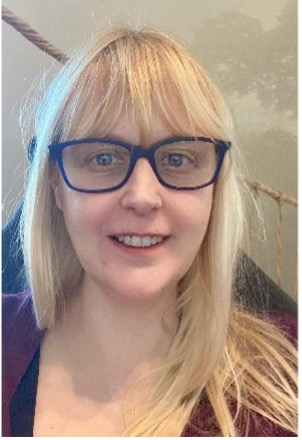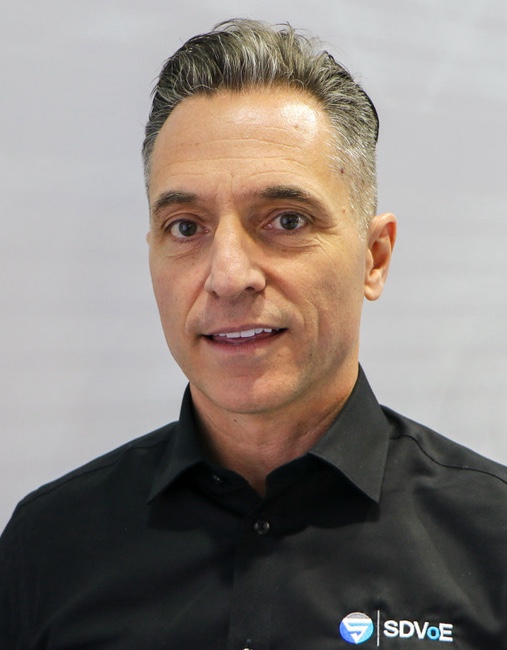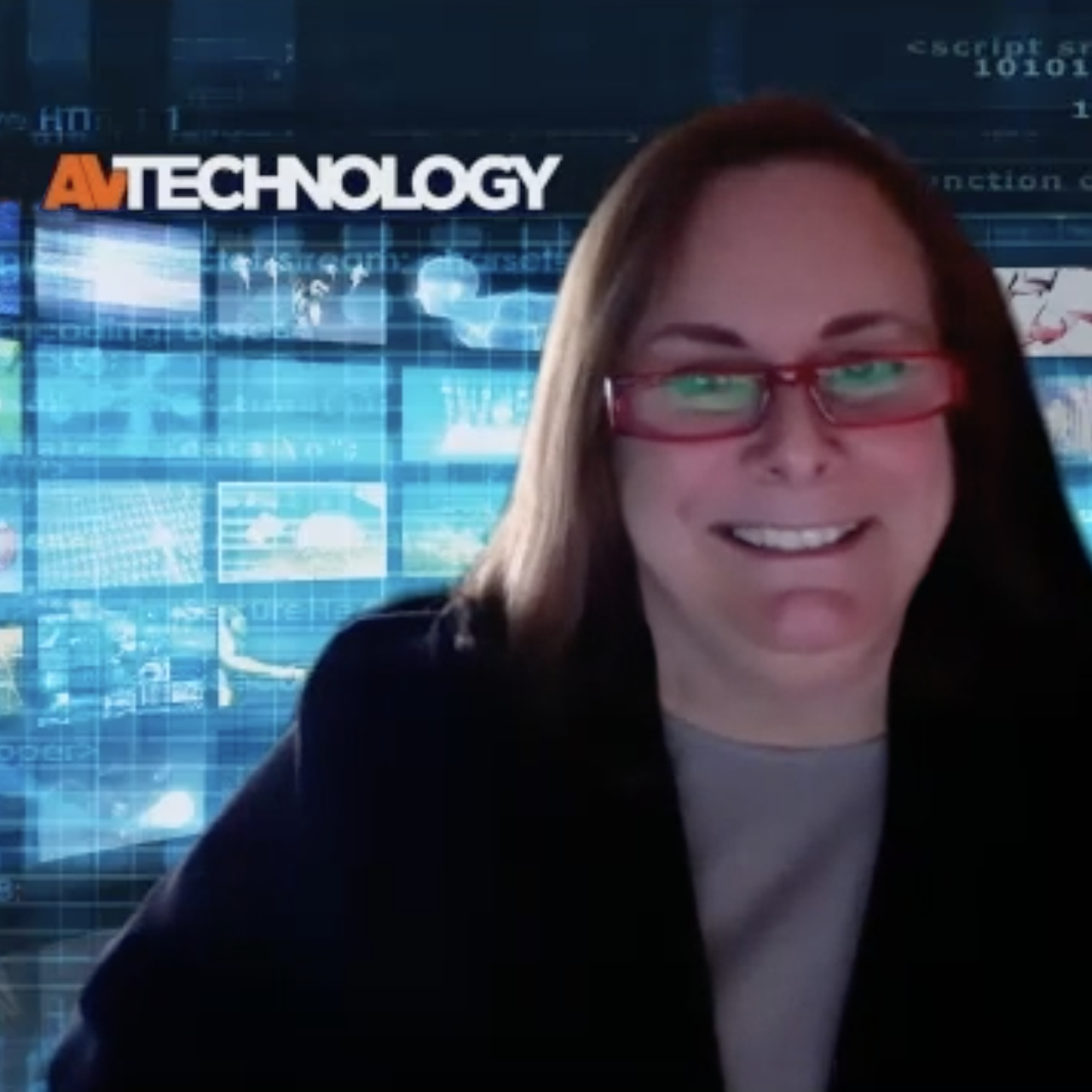Do you have legacy AV equipment that is still earning its keep? Does your organization have a combination of hardware and software from different manufacturers, and does interoperability sometimes pose an issue? Is your AV/IT department full speed ahead with AV over IP, the cloud, and AI-enabled systems?
No matter which end of the AV or IT spectrum your systems reside, these 25 industry thought leaders share insights into the transition to IP, trends in The State of AV/IT today, and predictions for the next few years.

CATHERINE KOUTSARIS
Product Marketing Manager at Matrox Video
For many organizations, the biggest hesitation in modernizing AV systems is the belief that moving forward means ripping everything out and starting from scratch. In reality, most end users don’t need or want to replace entire systems. What’s more practical and sustainable is keeping the elements that still work well and bridging them with newer technologies. This approach reduces staff retraining and avoids waste. Teams can then evolve at their own pace.
That’s where interoperability comes in. Today’s AV/IT environments often resemble technology islands—ecosystems that work well independently but don’t always communicate with one another. End users may value their existing cameras or video walls, but when new requirements emerge, incompatibility becomes a real obstacle. AV gateway products are a great way to bridge between older systems and newer technology, allowing both to be used in the same installation.
Standards-based solutions provide the clearest path forward. Open standards like IPMX and SMPTE ST 2110 make it possible to mix equipment from multiple manufacturers and reduce the risk of vendor lock-in. In practice, this can mean running day-to-day conferencing over a corporate 1GbE network while seamlessly shifting to a 10GbE broadcast workflow for high-end production—all with the same underlying infrastructure. Organizations gain freedom from vendor lock-in and proprietary constraints.
The advice for end users is to focus on flexibility. Prioritize systems that integrate with what you already have and embrace open standards. This approach ensures that today’s investments remain relevant, while giving you the freedom to adopt new technologies and build AI-over-IP systems that can grow with you on your own terms.

RICHARD JONKER
Vice President Marketing and Business Development at NETGEAR Enterprise
The most successful organizations are shifting their mindset from, “What AV equipment do we need?” to, “How can we create experiences that drive business results?” This approach means your AV investments should solve specific business challenges rather than simply upgrade hardware.
The proof is in your meeting rooms. Setup time has dropped from seven frustrating minutes to under twenty seconds. This translates to improved productivity and employee satisfaction.
Behind the shifting mindset are four key technologies reshaping how you’ll interact with AV systems: AV over IP, cloud solutions, artificial intelligence, and extended reality (XR/AR). These represent fundamental changes, creating practical benefits for organizations willing to evolve.
AV over IP leads this transformation by using your IP network infrastructure instead of dedicated AV cabling. This means you get to benefit from all the advantages of the network world: easier scaling when adding endpoints like speakers, microphones, or displays; when you need remote troubleshooting by IT teams without the need for room visits; better integration with existing security tools; and the flexibility to reconfigure spaces as needs change.
As your AV systems become networked, artificial intelligence transforms infrastructure management through automated configuration and intelligent power optimization. However, connectivity introduces security vulnerabilities requiring proactive protection. Modern solutions now integrate AI-driven network simplification with built-in cybersecurity capabilities, creating inherently secure, intelligent systems that adapt to threats while simplifying operations.
At NETGEAR, we believe that organizations investing in these transitions today—and focusing on experiences that solve specific business challenges—are positioning themselves for significant advantages as the market evolves.

SAM SABET
Executive Vice President and Chief Technology Officer at Shure
The simple answer for any customer looking to invest in new AV technologies today, whether for upgrading or otherwise, is to consider a flexible, adaptable platform. Today’s AV world is characterized by rapid and constant changes. These changes are evident both in the environment—workspaces, collaboration modes, and the balance between RTO and remote work—and in features and technologies such as AI, feature deployment speed, and processing power.
When choosing a platform, it’s imperative to keep in mind the ease of adaptability to evolving changes. Consider the flexibility of configuration and provisioning, as well as the longevity of the platform. Shure’s ecosystem of MXA and collaboration solutions, supported by software infrastructure like ShureCloud and our advanced DSP and AI algorithms, provides a perfect platform. It can automatically adapt and grow with our end users’ needs.

EMMA EAGLE
Manager of Marketing at Hall Research
When it comes to evolving AV systems, whether you’re replacing legacy gear or updating something relatively new, the key is to plan for what’s next—not just what’s now. AV and IT are no longer separate worlds. Your AV strategy should be as scalable, secure, and manageable as the rest of your IT infrastructure.
Don’t get stuck on spec sheets. Instead, ask: Will this system grow with us? Can it integrate with cloud platforms? Is it simple enough that anyone can use it without frustration? Because at the end of the day, simplicity drives adoption, and adoption drives ROI.
The next few years will bring even more AV over IP, smarter automation through AI, tighter cybersecurity requirements, and an increased demand for sustainable solutions. Organizations that embrace these shifts will be in the best position to maximize both their technology and their people.
My advice? Evolve with intention. Choose solutions that are scalable, secure, and user-friendly. That’s how you future-proof your AV/IT investments.

MAX RITCHER
Co-Founder and Vice President of Marketing at Insta360
The AV/IT industry is at a turning point..
We’re moving from static, hardware-first setups to flexible, cloud-connected ecosystems that are easier to manage and adapt to how people really work. Three forces are driving this shift: the cloud, AI, and interoperability.
Cloud platforms now sit at the center of modern AV, making it possible for IT teams to monitor and update systems across campuses or offices from one place. This reduces complexity and takes the burden off on-site staff.
AI adds another layer, turning AV from something reactive into something proactive. We’ve seen this in the evolution of Insta360’s enterprise tools. We came from humble (yet ambitious!) origins with the Link AI webcam. This was our first entry into the industry, already sporting smart tracking. We’ve now moved onto the Connect video bar for larger rooms, and our latest release, Insta360 Wave. As an AI speakerphone, we’ve crafted something that is adaptive and resilient, designed to work together with our other products as a seamless experience.
But none of this potential can be unlocked without interoperability. Proprietary systems have long slowed progress by creating silos and forcing users into narrow ecosystems. That’s why open standards matter. By supporting initiatives like OpenAV Cloud and pushing for shared APIs, the industry can break down barriers, give organizations more choice, and ensure systems can grow together instead of being locked in.
The convergence of cloud, AI, and interoperability is shaping the future of AV. We’re beyond just releasing flashy tech for its own sake. We’re building smarter, more reliable systems that actually make work easier and more connected for everyone.

OLIVER VAN CAMP
Product Director, Meeting Experience at Barco ClickShare
Today’s meeting room technology must do more than connect devices; it needs to enable seamless, inclusive collaboration for all meeting room users. That’s why Barco ClickShare and Microsoft are re-imagining hybrid collaboration through smarter, more human-centric meeting experiences.
ClickShare provides a secure, scalable meeting room system that lets room participants conference, collaborate, and present with just one click, with no technical hassle, no cables, and no delays. Intuitive and easy to use, ClickShare ensures the meeting experience is consistent and seamless across any space—from huddle rooms to large boardrooms—and is designed around how people truly work.
In a Microsoft Teams environment, this experience becomes more intelligent and user-friendly. AI-powered features like speaker recognition, automatic camera framing, and smart content sharing create meetings that feel more natural and engaging, whether participants are in the room or remote.
AI is now doing even more to support the flow of work. Features like speaker attribution (knowing who’s speaking), facilitator agent (a virtual assistant capturing next steps and deadlines), and interpreter agent (allowing everyone to speak in their native language) benefit both in-room and remote participants. These tools help overcome proximity barriers, reduce administrative tasks, minimize miscommunication, and integrate smoothly into everyday workflows—even as they are still emerging.
ClickShare brings wireless collaboration solutions into the meeting room, empowering companies to run AI applications locally and in real time via the ClickShare Base Units. This unlocks smarter, faster interactions—from live speaker recognition and automatic camera framing to translation and real-time note-taking—enhancing every interaction to keep users productive, engaged, and focused. Together, ClickShare and Microsoft are redefining hybrid meetings: secure, smart, scalable, and made for people.

RYAN WALLENBERG
AIMS Member and Vice President of Engineering at Cobalt Digital
Whether AV systems are for rich experiences in venues or for managing signals on campuses like businesses or universities, they often involve equipment from different tech categories. For example, in many organizations it is not rare to see mixtures of two or all three of the following things: media processing equipment, signal extension and switching equipment, and IT department equipment.
There are many factors that have made it possible to accomplish any task that previously required hardwired cables to be achievable using packetized IP. The most challenging thing left to overcome while migrating from hardwired cables to IP is dealing with mixing different equipment types, equipment classes, and vendor solutions with interfaces such as HDMI.
The two most important things that have happened to address this final challenge is the emergence of open standards and specifications—such as SMPTE ST 2110, AES67, NMOS, and IPMX—and the emergence of IP-to-IP gateway converters of many types to help deal with conversions of media profiles within the media options of the standards and between different media and protocols including proprietary options.
End users looking to evolve legacy or even newer AV systems should consider IPMX-compliant solutions that offer smooth plug-and-play integration. An optimized hybrid infrastructure will leverage interoperability for high-quality audio, video, and data for SMPTE ST 2110 transport across common networks. Organizations should be able to add capabilities at their own pace while avoiding vendor lock-in and giving them the flexibility to build infrastructures that grow with them. Several vendors have always offered modular and standards-based technologies that adapt to real-world challenges, and they are now embracing IPMX integration.

SKYLER BOWDEN
Senior Marketing Manager at Mersive
In today’s hype-heavy tech climate, AI gets most of the headlines. Promises of 10x productivity and AI-driven transformation abound—but for AV/IT professionals managing real systems, real spaces, and real users, it’s essential to cut through the noise.
The truth? AI will shape the future of collaboration—but it won’t fix broken workflows or magically modernize outdated AV infrastructure. Productivity gains only happen when technology is aligned with how people actually work, connect, and communicate. This is especially true in education, healthcare, and enterprise environments, where every decision has to balance performance, cost, security, and usability.
What’s often overlooked in the rush to optimize is a critical factor: the human experience. Meaningful technology doesn’t just improve business outcomes; it impacts how people feel about their work. When meetings are more efficient and tools actually support connection instead of complicating it, your teams regain focus, time, and energy. That’s where real value emerges: better engagement, clearer communication, and a healthier work-life balance.
The most exciting AI potential isn’t about replacing people; it’s about revealing insights. Meeting analytics can surface engagement trends, highlight contributor impact, and track follow-ups so no one flies blind. Instead of attributing all tasks to the in-room device, imagine a system that accurately reflects every participant’s input and commitments—remote or on-site.
So what’s the takeaway? Don’t get distracted by magic wands. Invest in technology that is secure, scalable, and user-friendly—solutions that create space for the innovation your teams are primed to deliver. Then, let AI help you fine-tune how your teams meet, share, and succeed—without forcing in one-size-fits-all tech that misses the mark on deeper challenges like process gaps. AI will naturally optimize efficiency, but not overnight and not without an intimate understanding of how your teams do their best work.

BLAKE ABIG
Director of National Sales at Full Compass Systems
In my role, I spend much of my time listening to colleges, universities, and corporations as they rethink how their AV systems support teaching and collaboration. One of the most common concerns I hear is that rooms feel inconsistent. A professor might walk into one classroom and everything works smoothly, then step into another and struggle to get the system started. The same frustration shows up in corporate offices. Consistency is one of the simplest ways to improve user confidence and adoption.
Another challenge customers raise is the pressure on lean support teams. Higher ed IT groups may be responsible for hundreds of classrooms, while corporate AV staff cover global meeting spaces. I often hear, “We can’t be everywhere at once.” This is where centralized, cloud-based monitoring really makes a difference. When teams can see issues in real time and push updates remotely, they spend less time firefighting and more time enabling productivity.
Clients are also curious about how artificial intelligence fits in. What I tell them is that AI works best when it disappears into the background. Cameras that automatically follow a presenter, microphones that remove noise, and live captions that improve accessibility all make the experience smoother without adding complexity.
Finally, one theme that comes up again and again is equity for remote participants. Whether it is a student joining from home or a colleague dialing in from another office, people expect to be seen and heard clearly. That is no longer optional; it is the baseline.
The most successful AV strategies I see are the ones that put people first. When systems are reliable, intuitive, and supportive of everyone in the room and beyond, the technology simply enables better outcomes.

MITCH RAUCH
U.S. Sales Director at Powersoft
As AV systems grow more complex and distributed, spanning corporate campuses, higher education institutions, and dynamic multi-use facilities, the role of the integrator is evolving just as quickly. Success in today’s audiovisual environments requires more than just great sound and video; it also depends on smooth, seamless integration with the broader IT infrastructure.
Legacy rack rooms and point-to-point signal paths are giving way to decentralized, IP-based infrastructures. AV-over-IP is no longer a trend—but the very foundation. In this environment, amplifiers are active, networked components capable of intelligent signal routing, system synchronization, and real-time control. As a result, integrators are becoming more involved in network design, such as IP addressing, VLANs, QoS, and switch configuration, which are as essential as gain structure and speaker coverage.
Cloud integration is accelerating the evolution of network-based devices. Remote monitoring and system management capabilities are quickly becoming indispensable. Whether diagnosing issues, pushing firmware updates, or fine-tuning performance from a distance, cloud connectivity empowers integrators to deliver faster, more efficient support, often before the client even notices a problem. The shift to cloud integration can save time, reduce site visits, and pave the way for recurring service models.
Through these advancements, our mission at Powersoft remains to deliver transparent, intelligible audio without distraction. We’ve embraced this evolution with platforms like Unica and Nota 142. Both Unica and Nota 142 are purpose built for decentralized, IT-friendly environments, and combine robust performance with smart design and native cloud connectivity. Unica and Nota 142 highlight our commitment to helping integrators meet today’s challenges while preparing for tomorrow’s demands by bridging the worlds of AV and IT with powerful, future-ready solutions.

JAKUB KOLACZ
Manager Product and Commercialization, Business Communication at Sennheiser
As AV systems become increasingly networked, end users are grappling with how to evolve their environments without creating disruption. Legacy software, fragmented device tools, and rising IT security expectations often slow progress—yet the demand for simpler, more scalable management is only growing.
Now is the time for end users to prepare for this new era of AV/IT convergence. The priority is ease of deployment and configuration. Complex setup processes not only consume valuable IT/AV resources but also increase the risk of errors. Solutions that enable devices to be onboarded quickly, with minimal dependencies, free teams to focus on higher-value tasks.
Next, interoperability and centralization are key. While many organizations still rely on a patchwork of vendor-specific tools, the future lies in platforms that embrace open standards and integration. By consolidating device management into a single, standardized platform, teams gain a clearer view of their systems and reduce friction across locations and departments.
Security remains non-negotiable. With AV fully part of the enterprise IT landscape, encryption, authentication, and role-based access are essential to protect both data and devices.
Finally, consider ongoing performance. Management shouldn’t stop at installation. Proactive monitoring, real-time alerts, and predictive maintenance help teams spot issues before they escalate, keeping collaboration spaces available and reliable.
IT and AV pros should consider feature-rich, cloud-based device management platforms offering them all of the above services and more, with room to scale as systems become even more complex in the future. Providing a centralized hub for devices ensures not only improved on-site or remote management, but also the ability to react quickly to any issues at the time they occur.
Looking ahead, the convergence of AV and IT will continue to accelerate. End users who prioritize simplicity, interoperability, and proactive management today will be best placed to evolve their systems tomorrow, without sacrificing security or reliability.

ART WEEKS
Project Manager at ZeeVee by Kramer
We’re at an inflection point where both integrators and end users are rethinking AV system design. The old rack-full-of-boxes model is giving way to multi-function components that combine switching, DSP, and control. The motivation isn’t just fewer devices; it’s lower total cost of ownership over the life of a system.
By consolidating functions, projects install faster, take up less rack space, draw less power, and reduce the number of potential failure points. That translates to fewer service calls, easier remote management, and reduced labor costs across the system lifecycle. Realistically, integrators can save thousands per room, per year, while giving clients a cleaner, more reliable experience. It also helps projects get approved faster because decision makers can see long-term savings rather than just the upfront price tag.
At the same time, high-performance environments—like large lecture halls or mission-critical control rooms—are pushing adoption of AVoIP. End users want ultra-low latency and the flexibility to scale on standard networks. Today, that often means choosing between 1Gb and 10Gb deployments, but we’re seeing more forward-thinking firms pre-install CAT-6a cabling even when starting at 1Gb. That future-proofs the space, making it easier and cheaper to upgrade when higher bandwidth is needed.
In short, the state of AV/IT today is about simplification without compromise, and the next few years will be defined by scalable networked video paired with systems designed to reduce complexity, cost, and risk.

JOHN KRUSE
Senior Field Solutions Architect at ViewSonic
The convergence of AV and IT is reshaping how organizations design and manage their technology ecosystems. For end users modernizing legacy systems—or even optimizing newer ones—the goal is no longer just to add AV, but to create connected, intelligent environments that align with enterprise IT strategies.
There are a number of important considerations that go into achieving this. First, interoperability is foundational. Proprietary silos, especially technology-based ones, are becoming less viable, so end users should prioritize solutions certified across major platforms—Teams, Zoom, Google Meet—and integrate these with control systems to ensure long-term flexibility.
The second consideration is keeping the cloud as your control layer. Cloud-enabled management is shifting from optional to essential. Remote monitoring, analytics, and centralized updates improve uptime, lower service costs, and scale across campuses and enterprises.
Third, consider that AI is moving mainstream. AI features are already raising user expectations—from camera framing and noise suppression to predictive diagnostics. The differentiator in the coming years will be how seamlessly these features enhance collaboration and reduce friction.
Fourth, remember that budgets are tight, so sustainability and ROI are under more scrutiny than ever. End users should look for solutions that extend product lifecycles through firmware updates, modular upgrades, and energy efficiency instead of requiring rip-and-replace strategies.
And finally, as AV lives fully on the network, alignment with corporate IT security standards is critical. Device-level protections and encrypted data handling must be built in—not bolted on.
The state of AV/IT today is one of acceleration—driven by interoperability, cloud-first management, and AI intelligence. End users who embrace openness, scalability, and sustainability will not only protect their investments but also position their organizations for smarter, more adaptable experiences in the years ahead.

PAUL HARRIS
CEO at Aurora Multimedia
For end-users looking to evolve their AV systems, I recommend attending industry trade shows like InfoComm, ISE, and NAB, among others, which provide a neutral platform to explore new technologies. Ignore the marketing, and what size booth, and who throws the best parties. Do not be a “zombie” tradeshow walker either. That is where you walk aimlessly and get sucked in by the pretty shows people put on, but miss what is right in front of you that can make a difference. Dealer and distributor local shows can work well, just understand the limitations and combine them with other research, as many of these shows will only show you what they sell and are aligned with, leaving out many other brands and new technologies.
If you really want to do what is right for your company, due diligence is everything. Talk directly with a variety of manufacturers and test the products yourself to see if they meet your requirements. Nothing is better than a good old-fashioned shootout between brands, especially if the end user is in control of it to make sure everything is on a proper playing field. All manufacturers are guilty of making their products sound as good as possible. That is simply marketing at its best or worst, for that matter.
Ask questions like what makes your technology better than the competition, what is your warranty, where is it made, what is the life span of the product, do you make the product (yeah, many companies just slap their name on OEM and pretend it is theirs, support, education, TAA compliant, and roadmap. Don’t fall into the AI trap where companies make it sound exciting from a buzzword. See that it really does what they say, regardless of the tag line. At the end of the day, you are solving a problem, and it does not matter what fancy wrapper it comes in; does it simply do what is advertised, and does it do it well?

ADAM SOWERS
Senior Manager, Business Development at Sony Electronics
As organizations evolve their AV systems, the integration of interoperability, cloud solutions, and AI is paramount. AV systems aren’t just about hardware anymore; now, it’s all about being open, smart, and working together seamlessly. Even the newest legacy systems must catch up with the demands of hybrid work, smarter buildings, and AI-powered experiences. How would this actually get done? By embracing interoperability.
For anyone choosing platforms, I’d recommend looking for those that support open architectures and APIs. This is because open systems make it much easier for all your devices and services to communicate with each other. Think of it this way: By choosing solutions that can grow and adapt, you’re making sure your tech keeps up with the times as best as possible and is set up to evolve as quickly as possible. If you haven’t yet, check out initiatives like OpenAV Cloud, of which Sony Electronics is a member, to help you stay ahead.
Additionally, we’re all aware of the impact AI is starting to have. For example, virtual assistants and service bots are not just for demos anymore. Tools like predictive maintenance and smart troubleshooting mean less downtime and happier users. Virtual attendants can automate routines, personalize rooms, and manage schedules with minimal fuss.
Over the next few years, the efforts to unite disparate systems to create holistic solutions will finally come together. To prepare for that, think about going for modular, cloud-native solutions that are ready for AI and can grow with your evolution path. And partner with brands—like Sony—that believe in interoperability and open standards.

NICOLE CORBIN
Vice President of Product at Utelogy Corporation
As AV and IT continue to converge, the future belongs to organizations that embrace interoperability, automation, and intelligent systems. From cloud control platforms to AI-driven workflows, the industry is moving into an era where your technology estate shouldn’t just be about how it’s managed, but about how it’s orchestrated (ideally remotely and automatically).
Legacy and even modern AV systems weren’t designed to support the kind of dynamic, scalable, and data-driven operations today’s enterprises demand, but that’s changing fast.
At Utelogy, we’re seeing end users evolve by connecting AI agents across their IT/AV environments to support services that manage device health, power scheduling, room utilization, and even energy-saving measures. But these agents need a toolkit to work—a platform that provides control, telemetry, configuration, and automation in real-time. That’s where the Utelogy Platform comes in, delivering innovations like Agentic AI on our MCP Server to solve these challenges.
Agentic AI brings a conversational interface to the heart of AV/UC operations. Issue a command like, “Restart all devices in Building B with recent alert history,” and the system not only executes it, but recommends how to turn that action into a self-healing event going forward. This is AI for productivity, not just novelty.
Our advice? Don’t be afraid to integrate. Whether you’re managing a few rooms or thousands of devices across campuses and continents, the right tools let you reduce manual effort, increase uptime, and make smarter decisions using the data you already have.
In the coming years, the winners won’t just be those who adopt the newest tech, but those who build agile, interoperable systems that allow humans and machines to work together. The future of AV/IT isn’t siloed; it’s smart, connected, and cloud-enabled.

JATAN SHAH
President at QSC
My advice to end users looking to evolve their AV systems is to focus on flexibility, scalability, and intelligence. Technology is moving quickly, and the most future-ready solutions are those that adapt as your needs change while simplifying day-to-day experiences.
One of the biggest shifts in the industry is the move toward full integration of AV, IT, and building systems. AV is no longer a standalone function; it’s becoming deeply embedded in the workplace and experiential design. This means organizations should seek out open platforms that can seamlessly integrate into broader ecosystems rather than locking into closed or siloed technologies.
Another important trend is the rise of AI and data-driven automation. Instead of just enabling meetings or presentations, AI is becoming the eyes and ears of the room, driving context-aware actions like presenter tracking, speaker detection, and intelligent room adjustments. This shift makes technology more intuitive, reduces friction for end users, and helps deliver consistent, high-quality experiences.
Scalability also plays a critical role. End users should think not only about solving today’s challenges, but also about whether their AV approach can expand across multiple spaces or campuses while continuing to deliver measurable outcomes. Collecting and analyzing data from connected systems will become essential for optimizing utilization, proving ROI, and informing future planning.
Ultimately, the future of AV/IT is about creating smarter, more connected environments that support collaboration and innovation. By prioritizing open, data-driven platforms, organizations can ensure they’re not just keeping up with change but actively shaping spaces that are efficient, adaptive, and human-centered.

KATHRYN TAUB
Senior Product Marketing Manager at Audinate
Over the past decade, AV over IP has become central to professional systems, with nearly every major manufacturer offering networked products. And yet, interoperability across brands remains uneven, and customers expect systems that are easy to deploy, adaptable, and capable of integrating devices from different vendors.
The main challenge is that many products are built on unique implementations that work within a single brand but don’t extend beyond it. Such closed systems may be reliable, but hinder specialized features, gradual upgrades, or integration with existing investments. Open standards offer a pathway toward compatibility, but progress is slow and adoption is uneven, usually limited to basic transport of media across the network. Licensable platform solutions have become a widely adopted alternative. Backed by dedicated engineering teams, they extend beyond basic transport to provide APIs, stronger security, monitoring, and cloud-based tools that work consistently across multiple manufacturers.
Interoperability is what ensures AV-over-IP systems meet expectations in practice. Reliable audio and video depend on devices working together without added latency or quality loss, regardless of brand. As networks grow from single rooms to campuses, interoperability allows them to scale without fragmentation or costly redesigns. Shared APIs and common control frameworks make management practical by giving integrators the visibility they need to simplify support. Security underscores the same point: A system is only as strong as its weakest device, and without network-wide encryption or access control, interoperability is incomplete. Systems must balance performance and flexibility so they can meet the distinct demands of any environment.
The future of AV over IP depends on interoperability. With common protocols, consistent testing, and manufacturer-agnostic design, the industry can build networks that scale and adapt with ease. Interoperability safeguards current investments while opening the door to the innovation and growth that will define the next generation of AV systems.

BRAD HINTZE
Executive Vice President of Global Marketing at Crestron
Ultimately, convergence is all about scale. While organizations grow and their services expand, every system has to evolve to support new demands. This doesn’t mean simply upgrading individual components; instead, it requires a strategic approach and selecting platforms that are built on scalable standards that can grow with an organization over time. This scalability isn’t enough on its own, though. The platforms must also offer flexibility to accommodate a diverse range of spaces and room configurations to address smaller huddle rooms and multifunctional boardrooms alike. When choosing solutions that balance both of these components, organizations can future-proof their environments while maintaining consistency and performance.
Just as important is the user experience, as the expectations of end users are rising rapidly.
Today’s employees walk into a room with a clear vision for how they want the space to operate. Basic connectivity and audiovisual capabilities are no longer sufficient. Organizations must enable people to use the room with an easy-to-use system that offers AI features such as transcription and notetaking—just like they have come to expect from their individual workspaces.
Success lies in selecting technologies that scale with your organization while enhancing the experience of every individual who interacts
with them.

KEITH YANKE
Vice President of Product & Solutions Marketing at Sharp Imaging
& Information Company of America
The AV/IT landscape is rapidly evolving, shaped by AI, cloud interoperability, and new display technology. For end-users upgrading legacy or newer AV systems, it’s important to consider scalability, security, and sustainability.
AI is transforming display intelligence. From content triggering based on audience behavior to predictive diagnostics and remote monitoring, AI makes systems smarter, more responsive, and easier to manage. Paired with cloud-based management, AV networks can be centrally controlled, ensuring updates are applied, standards upheld, and devices remain secure throughout their lifecycle.
As systems grow more interconnected, interoperability introduces both opportunity and risk—making security foundational. AV systems must be designed with lifecycle security in mind, including firmware and software support beyond deployment. With that, manufacturers will be expected to maintain robust protocols throughout a product’s life.
As display technologies evolve alongside AI and cloud, LED displays continue to gain momentum with chip-on-board (COB) and smaller pixel pitch options becoming more affordable. When paired with cloud-driven control, LED provides scalable, high-performance displays that integrate seamlessly into AV/IT ecosystems.
Immersive experiences—from simulation to projection mapping—are expanding as AI simplifies both content creation and the mapping process. Tasks that once required niche expertise now have easier learning curves, making immersive environments more accessible to broader markets and applications. Combined with cloud-based platforms, interoperable AV systems can deliver these experiences in ways that are seamless, adaptable, and scalable.
Sustainability has also become a decisive purchasing driver. Beyond efficient hardware, cloud interoperability supports smarter lifecycle management—optimizing usage, reducing waste, and extending product longevity. Combined with durable displays, this proves that performance and sustainability can align.
Looking ahead, AV/IT systems will be defined by their ability to adapt, connect, and contribute to intelligent, secure, and sustainable workplaces across industries.

EFFI GOLDSTEIN
President of the HDBaseT Alliance
Whether upgrading legacy installations or enhancing newer deployments, end users would be best served by adopting a strategy centered around proven, reliable standards.
Modern AV systems are expensive, and organizations need to be sure that today’s investment will support tomorrow’s requirements. Building on established protocols like HDBaseT helps teams avoid getting locked into a single vendor’s ecosystem, resulting in greater and faster access to equipment than when relying on one source. This flexibility is especially important when it comes to maintenance, replacement, and time-sensitive system expansion.
Another key factor that must be taken into consideration is maintaining full functionality of the interfaces being used. For example, USB-C has become ubiquitous in modern devices, but not all connectivity solutions support the same bandwidth, creating hidden bottlenecks. For example, when connecting a USB 3.0 camera, you don’t want it to be downgraded to USB 2.0 because a system’s connectivity infrastructure can’t handle the higher data rates. Quality standards ensure your investment performs at the level it was intended to.
An additional advantage of standards-based systems is their ability to support upgrades in stages rather than being forced into complete overhauls. HDBaseT’s backward compatibility means you can reuse existing components and upgrade others as needs evolve incrementally—all while staying within budget. This offers dual benefits: It’s more economically friendly for the organization, and it supports sustainability initiatives by extending equipment lifecycles.

PETRO SHIMONISHI
Director of New Business Development at Panasonic Projector and Display Americas
AV/IT convergence not only poses an opportunity to streamline workflows, but it also exposes the need for flexible, interoperable, and easy-to-use solutions. Delivering end-to-end workflow solutions is essential to empowering AV professionals to focus on what matters: creating shared experiences. Effective, efficient workflows allow users to deliver stronger results with fewer resources to maximize the value of AV systems.
We’ll continue to see more integrations between hardware and software providers to streamline workflows and give customers the ability to design, create, and manage applications with more ease than ever before. For instance, at Panasonic Projector and Display Americas, we recently partnered with XTEN-AV to develop an integration that allows AV professionals to specify the correct lens for their Panasonic projector. Corporate AV/IT teams can confidently create system designs, reducing guesswork and speeding installation of interchangeable lens projectors.
Another market trend we anticipate will continue is the evolution of simplicity in installations. Universities upgrading lecture halls or other spaces often require additional hardware to manage streaming, content sharing, and network integration. This can increase system complexity, which becomes challenging for tight spaces. Panasonic’s displays and projectors feature SDM card slots and our partnership with Matrox Video gives AV professionals the freedom to choose the AVoIP standard that best meets their needs, with a clean system design that’s flexible for the future.
The migration of AV system workflows to the cloud is accelerating. This transition will help power seamless, engaging content as siloed, proprietary systems inhibit integration and innovation. As a founding member of OpenAV Cloud, Panasonic aims to accelerate this transition by supporting OpenAPI standards and working with the association to create a cloud-to-cloud communication standard that drives easy, cross-platform collaboration.

JOE ANDRULIS
Executive Vice President of Corporate Development at Biamp
AI continues to transform the audiovisual landscape, integrating into both legacy and contemporary AV systems. For end users, this ongoing evolution represents an unprecedented opportunity to enhance meeting experiences while also simplifying system management and support.
Beyond traditional configuration and provisioning, AI is fundamentally reshaping how end users experience corporate meetings of all types, whether participants are in person, remote, or in a hybrid setting. The most remarkable aspect of this transformation is its invisibility. Participants benefit from sophisticated, AI-driven enhancements without ever sensing the technology working behind the scenes. This seamless integration is crucial for creating truly effective meeting environments that prioritize simplicity, speed, and unwavering reliability.
Modern conferencing solutions exemplify this invisible intelligence. All-in-one conferencing bars, for example, demonstrate how AI can elevate user experiences through intelligent features such as beamtracking technology, which actively monitors and intelligently mixes conversations to ensure remote participants feel fully engaged. Coupled with AI-powered noise reduction algorithms, these systems deliver crystal-clear voice reproduction that eliminates distractions and maintains professional communication standards.
Visual intelligence further enhances the experience through electronic pan-tilt-zoom cameras paired with auto-framing technology, ensuring all participants remain perfectly positioned regardless of their location or movement. This technology keeps everyone front and center, creating an inclusive environment where physical location becomes irrelevant to participation quality.
The impact of AI also extends into operational excellence, benefiting end users in other ways they may not realize. For technical support teams, AI provides unprecedented insights into system performance, enabling rapid problem identification and resolution. This enables support teams to implement predictive capabilities to address potential issues before they impact end users, transforming reactive support into proactive system optimization. This paradigm shift ensures that mundane technical issues are resolved automatically, while more complex challenges are anticipated and prevented, creating a seamless, uninterrupted meeting experience for all participants.

OMER BROOKSTEIN, Chief Executive Officer and Co-Founder at Xyte
For enterprise end users looking to evolve their AV systems, the most important step is ensuring a foundation that’s open and adaptable. Proprietary silos slow innovation and increase costs, while open APIs provide the flexibility to integrate best-in-class solutions and scale as needs change. That’s why OpenAV Cloud—an industry initiative focused on standardizing open, cloud-based APIs and fostering cross-platform collaboration—is so critical.
The value of choosing an OpenAV solution is clear: It delivers vendor-neutral flexibility, easier integrations and scalability, and faster support and troubleshooting—all while future-proofing AV/IT investments with the backing of industry leaders. With this foundation in place, enterprises can not only streamline today’s operations but also prepare for the intelligent automation that’s rapidly reshaping the industry.
The real opportunity today, however, lies in how AI will transform the way AV systems are supported, maintained, and experienced. AI-powered teammates are emerging as a force multiplier for IT and AV teams.
Autonomous issue resolution means that if a microphone drops mid-call, AI detects it and reboots or reroutes before users notice. With proactive scheduling and monitoring, AI forecasts failures from usage patterns and environmental data, then books service windows automatically. Context-aware support in hybrid meetings allows AI to adjust audio, cameras, and layouts to match participants and context. And finally, with self-service for end users, employees can resolve minor issues with AI-guided instructions, reducing IT workload.
AI in enterprise AV isn’t about replacing humans; it’s about augmenting teams with intelligent assistants that deliver resilience, efficiency, and better user experiences. Future-ready AV means building for both interoperability and intelligence—without one, the other cannot succeed. And with AI teammates stepping in to resolve issues, anticipate needs, and empower users, organizations that embrace this shift now will set the pace for the entire industry.

STEPHANE TREMBLAY
President of the SDVoE Alliance
Today, we’re recognizing that many integrators, IT managers, and end users are seeking solutions that deliver high-quality performance without requiring a complete rip and replace of existing infrastructure. As a result, AV over IP has emerged as a viable solution. By shifting AV distribution onto standard Ethernet networks, it enables organizations to harness the power of their current infrastructure while unlocking new levels of flexibility, scalability, and reliability. Unlike traditional systems that often depend on proprietary hardware and cabling, AV over IP integrates seamlessly into IT environments.
A key advantage of AV over IP, and particularly Software-Defined Video over Ethernet (SDVoE), is its ability to deliver high-performance video and audio with the reliability and interoperability that IT teams expect. With SDVoE technology, audiovisual functions become software-defined, meaning updates, enhancements, and even new features can be deployed through firmware rather than hardware replacement. A software-based approach offers significant future proofing, delaying obsolescence and protecting investments. In an era where supply chain disruptions and budget pressures remain real challenges, that flexibility matters.
Higher education, corporate facilities, houses of worship, and other verticals need standardized, interoperable solutions that scale to large spaces without compromising user experience. In higher education, for instance, AV over IP enables classrooms, lecture halls, and collaborative spaces to run on a consistent backbone, easing IT management and improving reliability.
Looking ahead, AV and IT continue to converge more closely. AV is no longer siloed, but treated as another service on the network, and is subject to the same demands for uptime, security, and scalability. Ethernet’s continued evolution, coupled with AV over IP’s flexibility, suggests that over the next few years, organizations will increasingly standardize on 10G Ethernet backbones. As a result, AV systems will become more reliable, interoperable, and adaptable to future needs, ensuring end users can keep pace with changing expectations without constant reinvestment.

